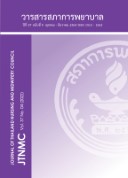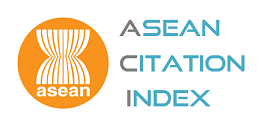ปัจจัยทำนายพฤติกรรมป้องกันการติดเชื้อโควิด 19 ในผู้เป็นโรคหืด
คำสำคัญ:
โรคหืด, โควิด 19, การป้องกัน, พฤติกรรมบทคัดย่อ
วัตถุประสงค์ของการวิจัย: เพื่อศึกษาอำนาจการทำนายของความรู้เกี่ยวกับโรคโควิด 19 การรับรู้โอกาสเสี่ยงต่อการติดเชื้อโควิด 19 การรับรู้ความรุนแรงของโรคโควิด 19 และการรับรู้สมรรถนะ ของตนเองในการป้องการติดเชื้อโควิด 19 ต่อพฤติกรรมป้องกันการติดเชื้อโควิด 19 ในผู้เป็นโรคหืด
การออกแบบการวิจัย: การวิจัยหาความสัมพันธ์เชิงทำนาย
วิธีดำเนินการวิจัย: กลุ่มตัวอย่างเป็นผู้เป็นโรคหืดอายุ 18 ปีขึ้นไปที่มาติดตามการรักษาที่คลินิก โรคหืด โรงพยาบาลระดับตติยภูมิขั้นสูงแห่งหนึ่ง ในกรุงเทพมหานคร จำนวน 119 ราย เก็บรวบรวมข้อมูล โดยใช้แบบบันทึกข้อมูลส่วนบุคคล แบบสอบถามความรู้เกี่ยวกับโรคโควิด 19 แบบสอบถามการรับรู้ โอกาสเสี่ยงต่อการติดเชื้อโควิด 19 แบบสอบถามการรับรู้ความรุนแรงของโรคโควิด 19 แบบสอบถาม การรับรู้สมรรถนะของตนเองในการป้องกันการติดเชื้อโควิด 19 และแบบสอบถามพฤติกรรมป้องกัน การติดเชื้อโควิด 19 วิเคราะห์ข้อมูลด้วยสถิติเชิงพรรณนาและการวิเคราะห์ถดถอยพหุคูณ
ผลการวิจัย: กลุ่มตัวอย่างสองในสาม (ร้อยละ 68.90) เป็นเพศหญิง อายุเฉลี่ย 64 ปี (SD = 11.80) มีพฤติกรรมป้องกันการติดเชื้อโควิด 19 อยู่ในระดับสูงร้อยละ 95.80 โดยตัวแปรทั้งหมด สามารถร่วมกันอธิบายความแปรปรวนของพฤติกรรมป้องกันการติดเชื้อโควิด 19 ในผู้เป็นโรคหืด ได้ร้อยละ 36.50 (R2 = .365, p < .001) โดยปัจจัยที่มีอิทธิพลสูงสุดคือ การรับรู้สมรรถนะของตนเอง ในการป้องกันการติดเชื้อโควิด 19 (β = .399, p < .001) รองลงมาคือ การรับรู้ความรุนแรงของโรคโควิด 19 (β = .283, p < .001) และการรับรู้โอกาสเสี่ยงต่อการติดเชื้อโควิด 19 (β = .206, P < .05) ตามลำดับ
ข้อเสนอแนะ: พยาบาลควรให้ข้อมูลเกี่ยวกับความรุนแรงของโรคโควิด 19 โอกาสเสี่ยงของ ผู้เป็นโรคหืดในการติดเชื้อโควิด 19 และส่งเสริมการรับรู้สมรรถนะของตนเองในการป้องกันการ ติดเชื้อโควิด 19 เพื่อให้ผู้เป็นโรคหืดมีพฤติกรรมป้องกันการติดเชื้อโควิด 19 ที่ดี
Downloads
References
Department of Disease Control, Ministry of Public Health. COVID-19 (EOC-DDC Thailand) Co-rona virus 2019 [Internet]. Nonthaburi: Department of Disease Control; [updated 2022 August 20; cited 2022 April 20]. Available from: https://ddc.moph.go.th/viralpneumonia/index.php (in Thai)
World Health Organization. Coronavirus disease (COVID-19) [Internet]. Geneva: WHO; 2020 [cited 2021 May 13]. Available from: https://www.who.int/health-topics/coronavirus#tab=tab_2
Jartti T, Bonnelykke K, Elenius V, Feleszko W. Role of viruses in asthma. Semin Immunopathol. 2020; 42(1):61-74. Doi: 10.1007/s00281-020-00781-5.
Center of Disease Control and Prevention. COVID-19: people with moderate to severe asthma [Internet]. 2021 [cited 2021 May 18]. Available from: https://www.cdc.gov/coronavirus/2019-ncov/need-extra-precautions/asthma.html
Calderon JAL, Martin PB, Rodriguez RG, Cataldi HSC, Sánchez CJS. Differentiating characteristics of patients with asthma in the severe acute respiratory syndrome coronavirus 2 infection. Ann Allergy Asthma Immunol. 2021;126(1):92-3. doi: 10.1016/j.anai.2020.09.004.
Williamson EJ, Walker AJ, Bhaskaran K, Bacon S, Bates C, Morton CE, et al. Factors associated with COVID-19-related death using OpenSAFELY. Nature. 2020;584(7821):430-6. doi: 10.1038/ s41586-020-2521-4.
Schultze A, Walker AJ, MacKenna B, Morton CE, Bhaskaran K, Brown JP, et al. Risk of COVID-19- related death among patients with chronic obstructive pulmonary disease or asthma prescribed inhaled corticosteroids: an observational cohort study using the OpenSAFELY platform. Lancet Respir Med. 2020;8(11):1106-20. doi: 10.1016/S2213- 2600(20)30415-X.
Adir Y, Humbert M, Saliba W. COVID-19 risk and outcomes in adult asthmatic patients treated with biologics or systemic corticosteroids: nationwide real-world evidence. J Allergy Clin Immunol. 2021;148(2):361-7 e13. doi: 10.1016/j.jaci. 2021.06.006.
Philip KEJ, Buttery S, Williams P, Vijayakumar B, Tonkin J, Cumella A, et al. Impact of COVID-19 on people with asthma: a mixed methods analysis from a UK wide survey. BMJ Open Respir Res. 2022;9(1): e001056. doi: 10.1136/bmjresp-2021-001056.
Zhong BL, Luo W, Li HM, Zhang QQ, Liu XG, Li WT, et al. Knowledge, attitudes, and practices towards COVID-19 among Chinese residents during the rapid rise period of the COVID-19 outbreak: a quick online cross-sectional survey. Int J Biol Sci. 2020;16(10): 1745-52. doi: 10.7150/ ijbs.45221.
Shahnazi H, Ahmadi-Livani M, Pahlavanzadeh B, Rajabi A, Hamrah MS, Charkazi A. Assessing preventive health behaviors from COVID-19: a cross sectional study with health belief model in Golestan Province, Northern of Iran. Infect Dis Poverty. 2020;9(06):91-9. doi: 10.1186/s40249-020-00776-2.
Chen Y, Zhou R, Chen B, Chen H, Li Y, Chen Z, et al. Knowledge, perceived beliefs, and preventive behaviors related to COVID-19 among Chinese older adults: cross-sectional web-based servey. J Med Internet Res. 2020;22(12):e23729. doi: 10.2196/23729.
Poonaklom P, Rungram V, Abthaisong P, Piralam B. Factors asociated with preventive behaviors towards Coronavirus disease (COVID-19) among adults in Kalasin Province, Thailand, 2020. OSIR Journal [internet]. 2020 [cited 2021 August 28];13(3):78-89. Available from: http://www.osirjournal.net/index.php/osir/article/view/211
Bunthan W, Whaikit P, Soysang V, Soynahk C, Akaratanapol P, Kompayak J. Factor influencing to health promotion behavior for Coronavirus disease 2019 (COVID-19) prevention of older adults. Journal of the Police Nurses [internet]. 2020 [cited 2021 August 28];12(2):323-37. Available from: https://www.tci-thaijo.org/index.php/policenurse/article/view/242662/167197 (in Thai)
Kim S, Kim S. Analysis of the impact of health beliefs and resource factors on preventive behaviors against the COVID-19 pandemic. Int J Environ Res Public Health. 2020;17(22):8666. doi: 10.3390/ijerph 17228666.
Strecher VJ, Rosenstock IM. The Health Belief Model. In: Glanz K, Lewis FM, Rimer BK, editors. Health behavior and health education: Theory, research, and practice. 2nd ed. San Francisco: Jossey-bass; 1997. p.41-59.
Jose R, Narendran M, Bindu A, Beevi N, Manju L, Benny P. Public perception and preparedness for the pandemic COVID 19: a health belief model approach. Clin Epidemiol Glob Health. 2021;9:41-6. doi: 10.1016/j.cegh. 2020.06.009.
Duan T, Jiang H, Deng X, Zhang Q, Wang F. Government Intervention, risk perception, and the adoption of protective action recommendations: evidence from the COVID-19 prevention and control experience of China. Int J Environ Res Public Health. 2020; 17(10):3387. doi: 10.3390/ ijerph17103387.
Yıldırım M, Geçer E, Akgul O. The impacts of vulnerability, perceived risk, and fear on preventive behaviours against COVID-19. Psychol Health Med. 2021;26(1):35-43. doi: 10.1080/13548506. 2020.177689.
Vázquez-Nava F, Vazquez-Rodriguez EM, VazquezRodriguez CF, Betancourt NVO, Ruiz OC, Rodríguez-Castillejos GC. Risk factors of non-adherence to guidelines for the prevention of COVID-19 among young adults with asthma in a region with a high risk of a COVID-19 outbreak. J Asthma. 2021;58(12): 1630-6. doi: 10.1080/02770903.2020.1818774.
González-Castro JL, Ubillos-Landa S, Puente-Martínez A, Gracia-Leiva M. Perceived vulnerability and severity predict adherence to COVID-19 protection measures: the mediating role of instrumental coping. Front. Psychol. 2021;12:2638. doi: 10.3389/fpsyg.2021.674032.
Dryhurst S, Schneider CR, Kerr J, Freeman AL, Recchia G, Van Der Bles AM, et al. Risk perceptions of COVID-19 around the world. J Risk Res. 2020;23(7-8):994- 1006. doi: 10.1080/ 13669877.2020.1758193.
Polit DF, Beck CT. Nursing research: generating and assessing evidence for nursing practice. 9th ed. Philadelphia: Wolters Kluwer Health; 2017.
Trongsakul S, Lambert R, Clark A, Wongpakaran N, Cross J. Development of the Thai version of Mini-Cog, a brief cognitive screening test. Geriatr Gerontol Int. 2015;15(5):594-600. doi: 10.1111/ggi.12318.
Khumsaen N. Knowledge, attitudes, and preventive behaviors of COVID-19 among people living in Amphoe U-thong, Suphanburi Province. Journal of Prachomklao College of Nursing, Phetchaburi Province [internet]. 2021 [cited 2021 August 1];4(1):33-48. Available from: https://www.tci-thaijo.org/index.php/pck/article/view/247955 (in Thai)
Best JW. Research in education. 3rd ed. Englewood Cliffs, NJ: Prentice-Hall; 1977.
Yodmai K, Pechrapa K, Kittipichai W, Charupoonpol P, Suksatan W. Factors associated with good COVID-19 preventive behaviors among older adults in urban communities in Thailand. J Prim Care Community Health. 2021;12:21501327211036251. doi: 10. 1177/21501327211036 251.
Iversen KK, Afzal S, Ahlström MG, Nordestgaard BG, Schneider UV, Nielsen L, et al. Lung function decline in relation to COVID-19 in the general population: a matched cohort study with prepandemic assessment of lung function. J Infect Dis. 2022;225(8):1308-16. doi: 10.1093/infdis/ jiab636.
Peng Z, Rojas ALP, Kropff E, Bahnfleth W, Buonanno G, Dancer SJ, et al. Practical indicators for risk of airborne transmission in shared indoor environments and their application to COVID-19 outbreaks. Environ Sci Technol. 2022;56(2):1125-37. doi: 10.1021/ acs.est.1c06531
Downloads
เผยแพร่แล้ว
How to Cite
ฉบับ
บท
License
Copyright (c) 2022 วารสารสภาการพยาบาล

This work is licensed under a Creative Commons Attribution-NonCommercial-NoDerivatives 4.0 International License.







